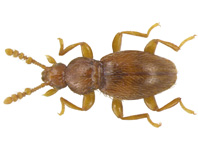Abstract
The euphorine braconid genus Marshiella is quite rare and enigmatic (Shaw and Marsh 2000). Shaw (1985) named this genus for two species previously included the genera Streblocera and Microctonus. Both species share the unusually heart-shaped modified, densely setose basal flagellomeres (as in Fig. 3) and are included in the tribe Townesilitini by Stigenberg et al. (2015) together with Townesilitus, Streblocera and Proclithrophorus, but the placement of the latter is controversial. Very little is known about the species of Marshiella, including their biology and diversity. They are presumed to be koinobiont endoparasitoids of adult Coleoptera; only one species, M. plumicornis (Ruthe) has been reared from a host, the anthicid beetle Notozus monceros L. They probably orient themselves to their hosts using chemical cues (Shaw and Marsh 2000). Their heart-shaped modified basal antenna are apparently modified for grasping the pronotal horn of their aggressive adult host during oviposition. Only nine species of Marshiella are currently known, two of them are from Oriental China (Yu et al. 2016).
References
Li, J., van Achterberg, C., Zhen, M.L. & Chen, J.H. (2020) A new species of Myiocephalus Marshall (Hymenoptera, Braconidae, Euphorinae) from China. Zookeys, 933, 95–106.
https://doi.org/10.3897/zookeys.933.49607
Shaw, S.R. (1985) A phylogenetic study of the subfamilies Meteorinae and Euphorinae (Hymenoptera: Braconidae). Entomography, 3, 277–370.
Shaw, S.R. & Marsh, P.M. (2000) Revision of the enigmatic genus Marshiella Shaw in the New World with the description of three new species (Hymenoptera: Braconidae: Euphorinae). Journal of Hymenoptera Research, 9 (2), 277–287.
Stigenberg, J., Boring, C.A. & Ronquist, F. (2015) Phylogeny of the parasitic wasp subfamily (Euphorinae: Braconidae) and evolution of its host preferences. Systematic Entomology, 40, 570–591.
https://doi.org/10.1111/syen.12122
van Achterberg, C. (1993) Illustrated key to the subfamilies of the Braconidae (Hymenoptera: Ichneumonoidea). Zoologische Verhandelingen Leiden, 283, 1–189.
Yu, D.S., van Achterberg, C. & Horstmann, K. (2016) Taxapad 2016, Ichneumonoidea 2015. Nepean, Ontario. [database on flash-drive]


